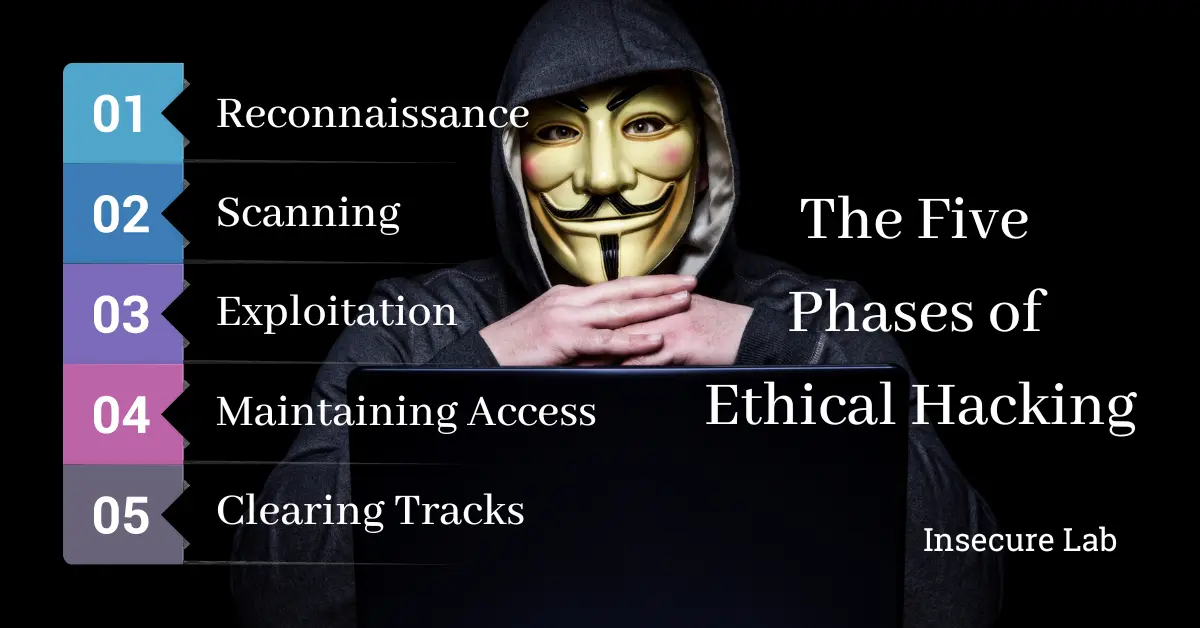Table of Contents
This cyber security guide highlights the five phases of ethical hacking: reconnaissance, scanning, gaining access, maintaining access, and clearing tracks.
The Five Phases of Ethical Hacking
Ethical hacking follows a structured and systematic approach to assess the security of computer systems and networks, known as the five phases of ethical hacking. Each of these 5 phases serves a specific purpose in identifying vulnerabilities and strengthening security measures.
Let’s delve into each of these phases to gain a better understanding of how ethical hackers operate:
Phase 1: Reconnaissance
This is the initial stage where the ethical hacker gathers as much information as possible about the target system, network, or resources. This phase is also known as footprinting or information gathering.
Key Activities:
- Passive Reconnaissance: Gathering information without directly interacting with the target. This involves collecting data from public sources such as websites, social media, and public records.
- Active Reconnaissance: Directly interacting with the target system to gather additional details such as network structures, system names, and IP addresses.
Tools and Techniques:
- Open-Source Intelligence (OSINT): Publicly available information like company websites, social media profiles, and job postings can reveal valuable details about the target’s systems, technologies, and security practices.
- DNS Records: Extracting information from a domain’s DNS records can expose details about the target’s network infrastructure.
- Social Engineering: Ethical hackers may use social engineering techniques to trick employees into revealing sensitive information. However, this is done with prior consent and authorization from the organization.
Phase 2: Scanning
This phase involves identifying live hosts, open ports, services, and key vulnerabilities in the network that could be exploited.
Key Activities:
- Port Scanning: Determining which ports are open on networked devices.
- Network Mapping: Outlining the physical and logical layout of the network.
- Vulnerability Scanning: Using automated tools to scan for known vulnerabilities.
Tools and Techniques:
- Port scanners like Nmap.
- Vulnerability scanners such as Nessus, OpenVAS, and Qualys.
- Web application scanners like OWASP ZAP and Burp Suite for specific web vulnerabilities.
Phase 3: Gaining Access
This stage involves using the vulnerabilities identified in the scanning phase to access the system, network, or resource. This is where the ethical hacker tries to exploit the system to understand the real-world impact of an attack.
Key Activities:
- Exploitation: Utilizing known vulnerabilities to gain unauthorized access. This may involve buffer overflows, injection attacks, and social engineering tactics.
- Privilege Escalation: Attempting to gain higher-level permissions on the system or network.
Tools and Techniques:
- Metasploit for automating the exploitation of vulnerabilities.
- Custom scripts or tools tailored to exploit specific vulnerabilities.
- Techniques for bypassing security measures like firewalls and intrusion detection systems.
Phase 4: Maintaining Access
In this phase, the hacker secures their access to the system for future exploration and analysis. This is typically used by malicious attackers to ensure persistent presence within the network to extract valuable data over time.
Key Activities:
- Installing Backdoors: Software or methods that bypass normal authentication to secure ongoing access.
- Deploying Rootkits: Tools that conceal the presence of the hacker and maintain privileged access.
Tools and Techniques:
- Tools like backdoor scripts, rootkits, and Trojans.
- Techniques for creating covert channels or stealth communication to evade detection.
Phase 5: Clearing Tracks
The final phase involves removing any signs of the hacking process to avoid detection by security systems or forensic investigations. This ensures the ethical hacker leaves the system as they found it.
Key Activities:
- Clearing Logs: Removing or altering logs that could indicate suspicious activities.
- Eliminating Evidence: Deleting any files or tools that were used during the hacking process.
Tools and Techniques:
- Log cleaners and file shredders.
- Techniques for restoring systems and data to their original state before the test.
Ethical Considerations and Legal Compliance
Ethical hackers must operate within the law and adhere to a strict code of ethics. Before beginning any penetration test, they must have explicit permission from the organization that owns the system. Ethical hackers should ensure their activities are documented, controlled, and aligned with the organization’s objectives.
Bottom Line
Each phase of ethical hacking plays a vital role in the comprehensive assessment of IT security infrastructure. By carefully planning and executing these phases, ethical hackers can help organizations strengthen their defenses against cyber threats. The process not only reveals vulnerabilities but also tests the organization’s incident response capabilities.

